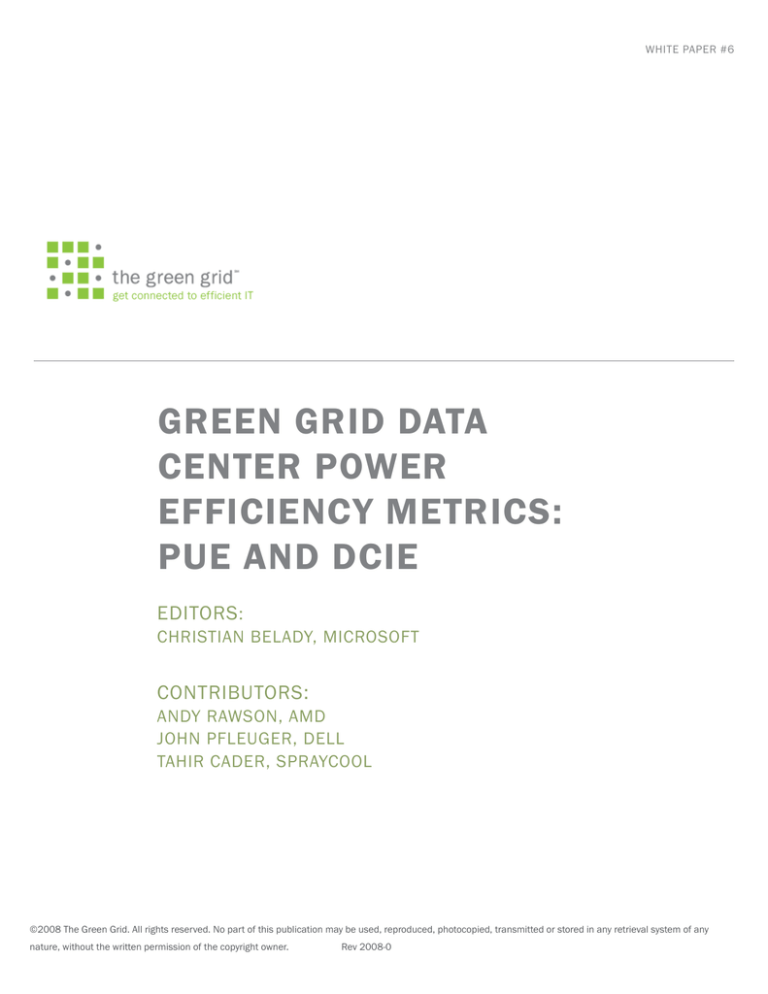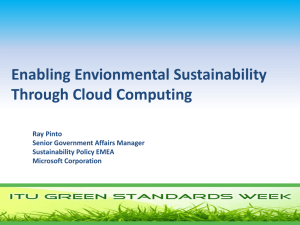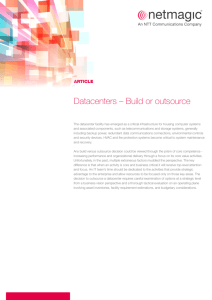
WHITE PAPER #6
GREEN GRID DATA
CENTER POWER
EFFICIENCY METRICS:
PUE AND DCIE
EDITORS :
CHRISTIAN BELADY, MICROSOFT
CONTRIBUTORS:
ANDY RAWSON, AMD
JOHN PFLEUGER, DELL
TAHIR CADER, SPRAYCOOL
©2008 The Green Grid. All rights reserved. No part of this publication may be used, reproduced, photocopied, transmitted or stored in any retrieval system of any
nature, without the written permission of the copyright owner.
Rev 2008-0
PAGE 2
ABSTRACT
The Green Grid is an association of IT professionals seeking to dramatically raise the energy efficiency of
datacenters through a series of short-term and long-term proposals. This is an update to the very first white
paper published by the Green Grid in February 2007 called “Green Grid Metrics: Describing Data Center
Power Efficiency” to refine the nomenclature and intent of that paper. In that paper, The Green Grid proposed
the use of Power Usage Effectiveness (PUE) and its reciprocal, Datacenter Efficiency (DCE) metrics, which
enable datacenter operators to quickly estimate the energy efficiency of their datacenters, compare the
results against other datacenters, and determine if any energy efficiency improvements need to be made.
Since then PUE has received broad adoption in the industry but DCE has had limited success due to the
misconception of what data center efficiency really means. As a result, this paper re-affirms the use of PUE
but redefines its reciprocal as datacenter infrastructure efficiency (DCiE). This refinement will avoid much of
the confusion around DCE and will now be called DCiE.
In the long term, The Green Grid is developing metrics to measure data center productivity as well as
efficiency metrics for all major power-consuming subsystems in the datacenter. To promote these metrics and
drive greater datacenter energy efficiency for businesses around the world, The Green Grid will publish future
white papers that provide detailed guidance on using these metrics. We will also continue to collaborate with
organizations such as the EPA, ECMA and Climate Savers that promote a similar goal and vision.
©2008 The Green Grid. All rights reserved. No part of this publication may be used, reproduced, photocopied, transmitted or stored in any retrieval system of any
nature, without the written permission of the copyright owner.
Rev 2008-0
PAGE 3
TABLE OF CONTENTS
INTRODUCTION......................................................................................................................................................4
BACKGROUND........................................................................................................................................................4
SHORT TERM (TACTICAL)......................................................................................................................................4
LONG TERM (STRATEGIC)......................................................................................................................................6
REFERENCES.........................................................................................................................................................9
©2008 The Green Grid. All rights reserved. No part of this publication may be used, reproduced, photocopied, transmitted or stored in any retrieval system of any
nature, without the written permission of the copyright owner.
Rev 2008-0
PAGE 4
INTRODUCTION
The Green Grid believes that several metrics can help data centers better understand and improve the energy
efficiency of their existing datacenters, as well as help them make smarter decisions on new datacenter
deployments. In addition, these metrics provide a dependable way to measure their results against
comparable IT organizations.
Why the need for greater energy efficiency? Because datacenter power and cooling are two of the biggest
issues facing IT organizations today, and growing companies need a way to control these costs while enabling
future expansion. With more efficient datacenters, IT organizations can better manage increased computing,
network, and storage demands, lower energy costs, and reduce total cost of ownership (TCO)—all while
remaining competitive and able to meet future business needs.1
BACKGROUND
The Green Grid is a non-profit trade organization of IT professionals that addresses power and cooling
requirements for datacenters and the entire information service delivery ecosystem. The Green Grid does not
endorse any vendor-specific products or solutions, but instead provides recommendations on best practices,
metrics, and technologies designed to improve overall datacenter efficiency.
SHORT TERM (TACTICAL)
The Green Grid recognizes the importance of establishing metrics for datacenter efficiency, and offers
guidance on technologies that claim to improve performance-per-watt. Ideally, these metrics and processes
will help determine if the existing datacenter can be optimized before a new datacenter is needed. In the
earlier white paper, the Green Grid supported two related metrics Power Usage Effectiveness (PUE)2 and
Datacenter Efficiency (DCE)2,3. Since then PUE has received broad adoption in the industry but DCE has had
limited success due to the misconception of what data center efficiency really means. As a result, this paper
re-affirms the use of PUE but redefines its reciprocal as datacenter infrastructure efficiency (DCiE). This
refinement will avoid much of the confusion around DCE and will now be called DCiE.
POWER USAGE EFFECTIVENESS (PUE) AND DATACENTER INFRASTRUCTURE EFFICIENCY (DCIE)
The PUE is defined as follows:
PUE = Total Facility Power/IT Equipment Power (1)
and its reciprocal, the DCiE is defined as:
DCiE =
1/PUE
=
IT Equipment Power/Total Facility Power x 100% (2)
For equations 1 and 2, the Total Facility Power is defined as the power measured at the utility meter — the
power dedicated solely to the datacenter (this is important in mixed-use buildings that house datacenters as
one of a number of consumers of power). The IT Equipment Power is defined as the equipment that is used
to manage, process, store, or route data within the data center. It is important to understand the components
for the loads in the metrics, which can be described as follows:
1. IT EQUIPMENT POWER. This includes the load associated with all of the IT equipment, such as compute,
storage, and network equipment, along with supplemental equipment such as KVM switches, monitors, and
workstations/laptops used to monitor or otherwise control the datacenter.
©2008 The Green Grid. All rights reserved. No part of this publication may be used, reproduced, photocopied, transmitted or stored in any retrieval system of any
nature, without the written permission of the copyright owner.
Rev 2008-0
PAGE 5
2. TOTAL FACILITY POWER. This includes everything that supports the IT equipment load such as:
• Power delivery components such as UPS, switch gear, generators, PDUs, batteries, and distribution losses
external to the IT equipment.
• Cooling system components such as chillers, computer room air conditioning units (CRACs), direct
expansion air handler (DX) units, pumps, and cooling towers.
• Compute, network, and storage nodes.
• Other miscellaneous component loads such as datacenter lighting.
The PUE and DCiE provides a way to determine:
• Opportunities to improve a datacenter’s operational efficiency.
• How a datacenter compares with competitive datacenters.
• If the datacenter operators are improving the designs and processes over time.
• Opportunities to repurpose energy for additional IT equipment.
While both of these metrics are essentially the same, they can be used to illustrate the energy allocation in
the datacenter differently. For example, if a PUE is determined to be 3.0, this indicates that the datacenter
demand is three times greater than the energy necessary to power the IT equipment. In addition, the ratio
can be used as a multiplier for calculating the real impact of the system’s power demands. For example, if a
server demands 500 watts and the PUE for the datacenter is 3.0, then the power from the utility grid needed
to deliver 500 watts to the server is 1500 watts. DCiE is quite useful as well. A DCiE value of 33% (equivalent
to a PUE of 3.0) suggests that the IT equipment consumes 33% of the power in the datacenter.
Figure 1: Illustration of How PUE and DCE Would Be Calculated In A Datacenter
In Figure 1, Total Facility Power is measured at or near the facility utility’s meter(s) to accurately reflect
the power entering the datacenter. This should represent the total power consumed in the datacenter.
©2008 The Green Grid. All rights reserved. No part of this publication may be used, reproduced, photocopied, transmitted or stored in any retrieval system of any
nature, without the written permission of the copyright owner.
Rev 2008-0
PAGE 6
The datacenter-only portion of a building utility meter should be measured since power not intended to
be consumed in the datacenter would result in faulty PUE and DCiE metrics. For example, if a datacenter
resides in an office building, total power drawn from the utility will be the sum of the Total Facility Power for
the datacenter, and the total power consumed by the non-datacenter offices. In this case the datacenter
administrator would have to measure or estimate the amount of power being consumed by the nondatacenter offices (an estimate will obviously introduce some error into the calculations).
IT Equipment Power would be measured after all power conversion, switching, and conditioning is completed
and before the IT equipment itself.
The most likely measurement point would be at the output of the computer room power distribution units
(PDUs). This measurement should represent the total power delivered to the compute equipment racks in the
datacenter.
The PUE can range from 1.0 to infinity. Ideally, a PUE value approaching 1.0 would indicate 100% efficiency
(i.e. all power used by IT equipment only). Currently, there are no comprehensive data sets which show
the true spread of the PUE for datacenters. Some preliminary work indicates that many datacenters may
have a PUE of 3.0 or greater, but with proper design a PUE value of 1.6 should be achievable4. This theory
is supported by measurements completed by Lawrence Berkley National Labs5 which shows that the 22
datacenters measured had PUE values in the 1.3 to 3.0 range. Other research indicates that PUE values of
2.0 are achievable with proper design6. However, there is currently no comprehensive industry data set that
shows accurate PUE statistics for datacenters.
Furthermore, there is no general agreement on what constitutes an efficient or inefficient datacenter. In
the future the Green Grid will offer values that profile target PUE and DCiE metrics for a variety of typical
datacenter configurations.
In the short term, The Green Grid suggests that datacenter owners begin using either the PUE or DCiE
metrics. While the measurement points may not be clearly defined, The Green Grid feels it is important to
begin measuring datacenter efficiency, even if the method currently requires data manipulation. In addition,
The Green Grid also encourages datacenter owners to share and compare their respective PUE and/or DCiE
results, which will help each datacenter owner better analyze their measurement methodology as well as
understand how their results compare to the rest of the industry.
LONG TERM (STRATEGIC)
A mixed-use building may house any number of functions, such as datacenter(s), labs, offices, etc. For these
types of mixed-use environments, determining the power usage of just the datacenter environment is difficult.
This is particularly true when the utility power grid enters the building through a single entrance point (e.g.,
through a utility room) and is then distributed to various building locations. These building configurations also
make it difficult to determine the power losses between the power entry into the building and its delivery to
the datacenter.
To further complicate the calculation of PUE and DCiE, the latest cooling technologies integrate cooling
elements such as pumps, refrigeration, blowers, and heat exchangers within the IT equipment itself.
These technologies blur the lines between what has traditionally been a clear delineation between facility
equipment and IT equipment. However, equipment used to provide power and cooling to the datacenter must
be accounted for in the metrics described in this paper.
©2008 The Green Grid. All rights reserved. No part of this publication may be used, reproduced, photocopied, transmitted or stored in any retrieval system of any
nature, without the written permission of the copyright owner.
Rev 2008-0
PAGE 7
As part of the effort to promote dramatic efficiency improvements in the datacenter, The Green Grid
will provide clearer distinctions between facility and IT equipment and recommend power consumption
measuring techniques throughout the datacenter, as well as for the equipment itself.
DATA CENTER PRODUCTIVITY (DCP)
For the long term, The Green Grid is working on metrics to define data center productivity. This is the natural
evolution from PUE and DCiE and such a metric could be in a form that looks as follows4:
Datacenter Productivity = Useful Work/Total Facility Power
While data center productivity is much more difficult to determine, members of The Green Grid feel that this
is a key strategic focus for the industry. In effect, this calculation defines the datacenter as a black box –
power goes into the box, heat comes out, data goes into and out of the black box, and a net amount of useful
work is done by the black box. This in some ways parallels the work being done with the EPA and Standard
Performance Evaluation Corporation (SPEC) at the server level in which the SPEC working group may
produce a standard on the performance of a system, and the EPA provides a process by which to measure
power consumed by the server. The Green Grid hopes to eventually increase the scope of that work to all IT
equipment and will require broad participation from the IT community to help guide and define this work.
FURTHER POWER USAGE EFFECTIVENESS (PUE) DEVELOPMENTS
The Green Grid will also consider the development of metrics that provide more granularity for the PUE and
DCiE metrics by breaking it down into the following components5:
PUE= 1/DCiE= Cooling Load Factor (CLF) + Power Load Factor (PLF) + 1.0
Where all factors are ratios that are divided by the IT Load and:
• 1.0 represents the normalized IT Load. Effectively this is the IT Load Factor (ILF) but is always 1.0.
• Cooling Load Factor (CLF) is the total power consumed by chillers, cooling towers, computer room air
conditioners (CRACs), pumps, etc. divided by the IT Load.
• Power Load Factor (PLF) is the total power dissipated by switch gear, uninterruptible power supplies (UPSs),
power distribution units (PDUs), etc. divided by the IT Load.
These metrics will be designed to address the blurring of the lines between the IT equipment and facility
infrastructure as discussed above. The Green Grid will look at these and other possible PUE and/or DCiE
related metrics in the future.
COMPONENT EFFICIENCY STANDARDS
The Green Grid will also work with the industry to define energy efficiency guidelines for all of the components
in the datacenter. Such components include the following:
• Uninterruptible power supplies (UPS)
• Switch gear
• Chillers
• Computer room air conditioners
©2008 The Green Grid. All rights reserved. No part of this publication may be used, reproduced, photocopied, transmitted or stored in any retrieval system of any
nature, without the written permission of the copyright owner.
Rev 2008-0
PAGE 8
• Direct expansion (DX) units
• Pumps
• Cooling tower
• Generators
• Distribution losses external to the racks
• Power distribution units (PDUs)
• Batteries
• Lighting
• Servers
• Storage
This effort will require close collaboration with other industry bodies such as the American Society for
Heating, Refrigeration, and Air Conditioning Engineers (ASHRAE).
CONCLUDING REMARKS
In addition to developing best practices, metrics, guidelines, and standards to help improve data center
efficiency, The Green Grid also proposes defining metrics at the rack level as rack-level cooling solutions
become more prominent. The group will also offer guidance for measuring both power consumption and
“useful work” at both the facility and rack levels, and will continue to provide technical updates as these
metrics and measurement techniques evolve. In the meantime, The Green Grid recommends the use of
either PUE or its reciprocal, DCiE.
©2008 The Green Grid. All rights reserved. No part of this publication may be used, reproduced, photocopied, transmitted or stored in any retrieval system of any
nature, without the written permission of the copyright owner.
Rev 2008-0
PAGE 9
REFERENCES
1
Patterson, M.K., Costello, D., Grimm P, Loeffler, M. (2007) “Data Center TCO; A Comparison of High-density
and Low-density Spaces,” THERMES 2007, Santa Fe, NM
2
Malone, C., C. Belady. (2006) “Metrics to Characterize Data Center & IT Equipment Energy Use,”
Proceedings of 2006 Digital Power Forum, Richardson, TX. http://cool.rsn.hp.com/papers/200609%20
DPF%20Final.pdf\t_parent
3
Rassmussen, N., “Electrical Efficiency Modeling of Data Centers,” White Paper #113, APC. (2005). http://
www.apcmedia.com/salestools/NRAN-66CK3D_R1_EN.pdf
4
Belady, C., “How to Minimize Data Center Utility Bills,” Line 56. (September 5, 2006). https://www.line56.
com/articles/default.asp?ArticleID=7881” http://www.line56.com/articles/default.asp?ArticleID=7881
5
Greenberg, S., E. Mills, B. Tschudi, P. Rumsey, and B. Myatt. (2006). “Best Practices for Data Centers:
Results from Benchmarking 22 Data Centers.” Proceedings of the 2006 ACEEE Summer Study on Energy
Efficiency in Buildings. http://eetd.lbl.gov/emills/PUBS/PDF/ACEEE-datacenters.pdf
6
Patterson, M.K., Pratt, A., Kumar, P., “From UPS to Silicon, an End-to-End Evaluation of Data Center
Efficiency, Proceedings of the EPA Event: Enterprise Servers and Data Centers: Opportunities for Energy
Savings.” (February 2006) HYPERLINK “http://www.energystar.gov/ia/products/downloads/MPatterson_
APratt_Case_Study.pdf”,“http://www.energystar.gov/ia/products/downloads/MPatterson_APratt_Case_
Study.pdf” http://www.energystar.gov/ia/products/downloads/MPatterson_APratt_Case_Study.pdf
©2008 The Green Grid. All rights reserved. No part of this publication may be used, reproduced, photocopied, transmitted or stored in any retrieval system of any
nature, without the written permission of the copyright owner.
Rev 2008-0





